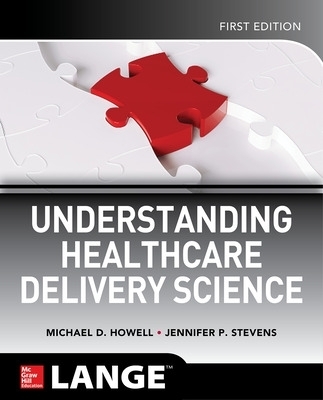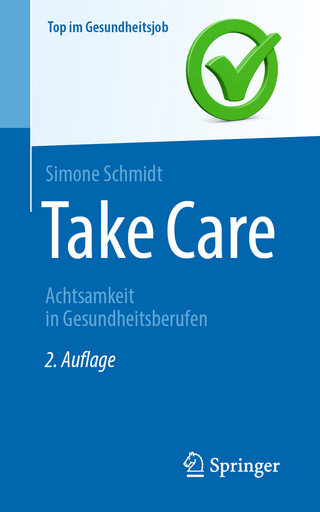
Understanding Healthcare Delivery Science
McGraw-Hill Education (Verlag)
978-1-260-02648-1 (ISBN)
A Doody’s Core Title for 2024!
“... a landmark text that will shape the field and inform our dialog for years to come—-and it should be part of the required curriculum at medical and nursing schools around the world. Excellence in healthcare delivery science should become a core competency of the modern physician. Howell and Stevens have given medicine an important gift that may enable just that.”
—Sachin H. Jain, MD, MBA, FACP; President and CEO, CareMore and Aspire Health; Co-Founder and Co-Editor-in-Chief, Healthcare: The Journal of Delivery Science and Innovation
“You hold in your hands 35 years of investigation and learning, condensed into understandable principles and applications. It is a guidebook for effective care delivery leadership, practice, and success.”
—Brent C. James, MD, MStat, Clinical Professor, Stanford University School of Medicine
“...a must-read for anyone who, like me, is frustrated with the pace of our progress and is committed to creating a learning health system for all.”
—Lisa Simpson, MB, BCh, MPH, FAAP, President and CEO, AcademyHealth
“... will quickly become the go-to, must-read resource for practitioners looking to have an impact as innovators in healthcare delivery.”
—David H. Roberts, MD, Steven P. Simcox, Patrick A. Clifford, and James H. Higby Associate Professor of Medicine, Harvard Medical School
Today’s healthcare system is profoundly complicated, but we persist in trying to roll out breakthroughs as if the healthcare system were still just the straightforward “physician’s workshop” of the early 20th century. Only rarely do we employ research-quality analytics to assess how well our care delivery innovations really work in the practice. And shockingly, the US healthcare delivery system spends only 0.1% of revenue on R&D in how we actually deliver care.
Small wonder that we find ourselves faced with the current medical paradox: Treatments that seemed miraculous at the beginning of our lifetimes are routine today, but low-quality care and medical errors harm millions of people worldwide even as spiraling healthcare costs bankrupt an unacceptable number of American families every year.
Healthcare delivery science bridges this gap between scientific research and complex, real-world healthcare delivery and operations.
With its engaging, clinically relevant style, Understanding Healthcare Delivery Science is the perfect introduction to this emerging field. This reader-friendly text pairs a thorough discussion of commonly available healthcare improvement tools and top-tier research methods with numerous case studies that put the content into a clinically relevant framework, making this text a valuable tool for administrators, researchers, and clinicians alike.
Michael Howell, MD MPH is a nationally recognized expert on healthcare quality and patient safety who has served on quality- and safety-related national advisory panels for the CDC, Medicare, the National Academy of Medicine, and others. An active healthcare delivery scientist with more than 100 research articles, editorials, and book chapters, his research has been covered by The New York Times, CNN, and Consumer Reports. Jennifer Stevens, MD directs the Center for Healthcare Delivery Science at Beth Israel Deaconess Medical Center in Boston, MA. A member of the Harvard Medical School faculty since 2015, she is actively training the next generation of healthcare delivery scientists. Dr. Stevens' research on the opioid epidemic in ICUs, new ways to identify and mitigate patient harm in overtaxed ICUs, and other critical healthcare delivery science issues has been featured in the Washington Post, NPR, and on the front page of the Boston Globe.
PART I: WHAT IS HEALTHCARE DELIVERY SCIENCE, AND WHY DO WE NEED IT?
Chapter 1
Introduction
The Problem: How Research and Operations Are Organized in Healthcare Today
Historical Context: How Did It Get This Way?
Why Now Is Different: Two Key Changes in Context
Why It Matters: Problems with Thinking Too Simply About Healthcare
Healthcare Delivery Science
References
Chapter 2
Complexity
What Happens When We View Healthcare as Complicated?
What Is a Complex Adaptive System?
Why It Matters: Fitting the Right Measurement Tool to the Question
Healthcare Delivery Science: A Field of Research Where Healthcare Itself Is the Organism Under Study
References
Chapter 3
Quality and Safety in Healthcare
The Best the World Has Ever Seen
Three Critical Papers to Know
An Inflection Point: To Err Is Human and Crossing the Quality Chasm
More Recent Estimates About Deaths from Medical Error
International Comparisons
Have Improvement Efforts Worked?
How We Put It All Together
References
Chapter 4
What Does the Future Hold?
Introduction
Value Drives Change
The “Postsafety” Era
Healthcare Delivery That Delivers Health
Consumerism Versus Personalization
The Doctor Will See You Now?
Informed Healthcare Information Technology (IT)
Conclusions
References
PART II: MAKING CHANGE IN THE REAL WORLD—TOOLS FOR HEALTHCARE IMPROVEMENT
Chapter 5
Human Factors
Human Factors: An Introduction
Cognitive Reasoning, Errors, and Biases in Healthcare
Hierarchy: What Is It, How Do We Measure It, and Why Does It Matter?
Tools for Understanding Complex Systems
Conclusions
References
Chapter 6
How Teams Work
Types of Teams
What Do Teams Need to Succeed?
Poorly Functioning Teams in Healthcare
Teams in Aviation and the Birth of Crew Resource Management (CRM)
CRM in Healthcare
Leading Teams Through Change
References
Chapter 7
Leadership and Culture Change
Leading Change Is Difficult
Where to Start
What Is Implementation Science?
Implementation Science Frameworks
Integrating Implementation Science Frameworks for the Purpose of Change Management
References
Chapter 8
Standard Quality Improvement Tools and Techniques
Introduction
Preventing Adverse Events and Improving Patient Safety
Identifying Patient Safety Events
Root Cause Analysis (RCA)
Failure Mode Effects (and Criticality) Analysis (FMEA and FMECA)
Safety I and Safety II
Process Improvement and Quality Improvement
References
Chapter 9
Lean Improvement Techniques in Healthcare
A Brief History of Lean
The Rules of Lean
A Concrete Definition of the Ideal
The 8 Wastes
Tools from Lean
Summary
References
Chapter 10
Partnering with Community, Professional, and Policy Organizations
Introduction
How Health Is Created
Key Stakeholders in Shaping Health
Engaging with Local Public Health Agencies
Approaches to Successful Partnerships
Concluding Thoughts
Acknowledgments
References
PART III: SEEING THE TRUTH—ANALYTICS IN HEALTHCARE
Chapter 11
Data in Healthcare
Part 1: Fundamental Issues in Healthcare Data
Part 2: The Importance of Understanding Data Lineage, and How This Leads Mature Organizations to Both Informal and Formal Data Governance
Part 3: Basic Understanding of Relational Database Structures
Part 4: Review of Common Approaches to Actually Accessing Healthcare Data
Conclusion
References
Chapter 12
Measuring Quality and Safety
Quality Measurement Frameworks
What Are You Trying to Achieve? Improvement, Comparison, or Accountability
What Makes a Good Measure?
Challenges
Common Measure Sets and Major Pay-For-Performance Programs
References
Chapter 13
Overview of Analytic Techniques and Common Pitfalls
Dinosaur Footprints and What They Tell Us About Data Analysis in Healthcare
The Four Horsemen of Mistaken Conclusions
The Critical Importance of Missing Data
The Shape of Data: Categories of Data and Why They Matter
Overview of Analytic Methods
References
Chapter 14
Everyday Analytics
Summarizing Your Data
Displaying Data
Outcomes Over Time, Part I – Run Charts
How to Tell if Two Groups Are Different: Univariable Tests of Difference and Measures of Comparison
Outcomes Over Time, Part 2—Statistical Process Control (SPC) Charts
Everyday Analytics
References
Chapter 15
Survey-Based Data
Introduction
Perhaps the Most Important Thing You’ll Learn in This Chapter
What Are Some of the Main Purposes of Surveys?
Overview of Conducting a Survey
Some Pitfalls
References
Chapter 16
Predictive Modeling 1.0 and 2.0
What to Expect in This Chapter
Predictive Modeling 1.0
Predictive Modeling 2.0
Taking Predictions to the Next Level
References
Chapter 17
Predictive Modeling 3.0: Machine Learning
Definitions: What Is Artificial Intelligence? Machine Learning?
A Brief History of Artificial Intelligence
Translating Epidemiology to Machine Learning
Categories of Machine Learning Used in Healthcare
Pitfalls in Using Machine Learning in Healthcare
The Future
References
Chapter 18
What Everyone Should Know About Risk Adjustment
What Is Risk Adjustment, and Why We Should Care?
What Risk Adjustments Are Available, and How Should We Assess Them?
Examples of Risk Adjustment Gone Awry
Using Risk Adjustment in Local Healthcare Delivery Science
References
Chapter 19
Modeling Patient Flow: Understanding Throughput and Census
Why Does Understanding Patient Flow Matter?
Understanding Patient Flow Conceptually
Analytical Approaches to Understanding Patient Flow
Summary
References
Chapter 20
Program Evaluation
Causal Methods
Quasi-Experimental Designs—Causal Inference in Observational Data
Evaluations in the Real World
References
Chapter 21
How to Embed Healthcare Delivery Science Into Your Health System
Introduction
How Do I Join (or Build) a Community of Healthcare Delivery Science?
How to Embed Healthcare Delivery Science in Your Health System
Summary
Reference
Index
| Erscheinungsdatum | 23.12.2019 |
|---|---|
| Zusatzinfo | 45 Illustrations |
| Verlagsort | OH |
| Sprache | englisch |
| Maße | 188 x 234 mm |
| Gewicht | 846 g |
| Themenwelt | Medizin / Pharmazie ► Allgemeines / Lexika |
| Medizin / Pharmazie ► Zahnmedizin | |
| ISBN-10 | 1-260-02648-5 / 1260026485 |
| ISBN-13 | 978-1-260-02648-1 / 9781260026481 |
| Zustand | Neuware |
| Haben Sie eine Frage zum Produkt? |
aus dem Bereich


